I. Fundamentals
Chords in SATB style
Samuel Brady
Key Takeaways
- When constructing a chord in SATB style, there are six rules to keep in mind:
Music theorists sometimes simplify compositions into four parts (or voices) in order to make their harmonic content more readily accessible. This practice is called SATB style, abbreviated after the four common voice parts of a choir––soprano (S), alto (A), tenor (T), and bass (B).
When constructing a chord in strict SATB style, there are six rules musicians generally follow:
These six parameters form the basis of counterpoint and part writing, explored further in the sections Counterpoint and Galant Schemas and Diatonic Harmony, Tonicization, and Modulation.
Stem Direction
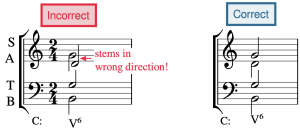
On a grand staff in SATB style, the soprano and alto are written in the treble clef (upper staff), while the tenor and bass are written in the bass clef (lower staff). The soprano and tenor voices receive up-stems, while the alto and bass parts receive down-stems. If the stem direction is crossed, this is an error. Example 1 shows a chord with incorrect stemming, followed by the corrected version.
Chord Construction
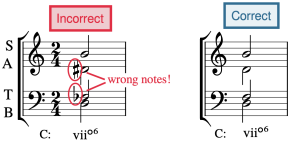
Be sure to check each chord for correct notes and accidentals, and make sure that your chords are not missing any notes. In Example 2, the first chord has accidentals erroneously added to two of the pitches, which are removed in the second chord to create a correct B diminished triad in first inversion.
The bass voice must always correspond with the inversion that the Roman numeral’s figures indicate. However, the order of the upper notes can be arranged in many ways. In other words, there is not necessarily just one correct way to voice a chord.
Range
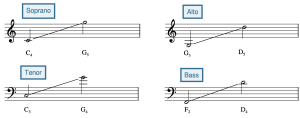
There is a generally accepted range for each voice (Example 3):
- Soprano – C4 to G5
- Alto – G3 to D5
- Tenor – C3 to G4
- Bass – F2 to D4
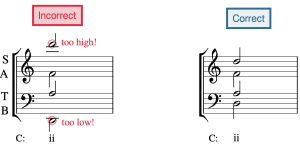
In Example 4, the soprano and bass notes are out of range; this is corrected by moving the soprano note down by an octave and the bass note up by an octave.
Spacing
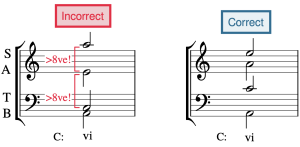
There should be no more than an octave between adjacent upper voices (soprano and alto, alto and tenor) and no more than a twelfth between the tenor and bass. The most common spacing error occurs between the alto and tenor because the notes appear in different clefs. Example 15 first shows a chord with incorrect spacing—the soprano and alto are more than an octave apart, as are the alto and tenor—followed by a corrected version:
Voice Crossing
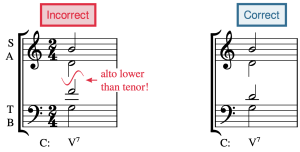
The ranges of voices should not cross. In other words, the soprano must always be higher than the alto, the alto must always be higher than the tenor, and the tenor must always be higher than the bass. In Example 6, the alto and tenor voices are crossed. This error is also the most common between the alto and tenor voices.
Doubling
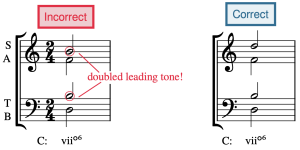
In a triad, the note in the bass is usually doubled in an upper voice. However, there is an exception to this: the leading tone is never doubled. Other tendency tones, such as chordal sevenths, are also never doubled. Seventh chords don’t have any notes doubled because they contain four notes, one for each voice part. Incorrect doubling is seen in the first measure of Example 7, where the leading tone is doubled, followed by a corrected voicing in the second measure.
Coming soon!
Media Attributions
- Stemming © Megan Lavengood is licensed under a CC BY-NC-SA (Attribution NonCommercial ShareAlike) license
- Wrong-notes © Megan Lavengood is licensed under a CC BY-NC-SA (Attribution NonCommercial ShareAlike) license
- Range © Megan Lavengood is licensed under a CC BY-NC-SA (Attribution NonCommercial ShareAlike) license
- Too-high © Megan Lavengood is licensed under a CC BY-NC-SA (Attribution NonCommercial ShareAlike) license
- Spacing © Megan Lavengood is licensed under a CC BY-NC-SA (Attribution NonCommercial ShareAlike) license
- Voice-crossing © Megan Lavengood is licensed under a CC BY-NC-SA (Attribution NonCommercial ShareAlike) license
- Doubled_lt © Megan Lavengood is licensed under a CC BY-NC-SA (Attribution NonCommercial ShareAlike) license
A musical texture with soprano (S), alto (A), tenor (T), and bass (B) parts.
On a grand staff in SATB style, the soprano and tenor are up-stemmed, while the alto and bass are down-stemmed.
The pitch content of a chord.
The span of notes a voice or instrument can produce.
The intervals between voices. For chords in strict SATB style, there should be no more than an octave between upper voices (soprano and alto, alto and tenor), and no more than a twelfth between the tenor and bass.
When a higher voice part moves below a lower voice part. In strict SATB style, the ranges of voices should not cross; the soprano must always be higher than the alto, the alto must always be higher than the tenor, and the tenor must be higher than the bass.
Duplicating some notes of a chord in multiple parts.
An independent, monophonic part within a piece of music (instrumental or vocal). Each voice may be played by a different instrument, or multiple voices may be played by one instrument (especially in polyphonic instruments like keyboard or guitar).
The highest part in SATB style, written in the treble clef staff with an up-stem; its generally accepted range is C₄–G₅.
The second-highest voice part in SATB style, written in the treble clef staff with a down-stem; its generally accepted range is G₃–D₅.
The second lowest part in SATB style, written in the bass clef staff with up-stems; its generally accepted range is C₃–G₄.
The lowest voice in SATB style, written in the bass clef staff with a down-stem; its generally accepted range is F₂–D₄.
The act of mirroring pitch content vertically, so that motion down becomes up and up becomes down. Inversion often preserves intervallic content.
Arabic numerals and symbols that indicate intervals above a bass note. These are realized into chords and non-chord tones by musicians.
Scale degree 7 that is one half step below the tonic. The leading tone is diatonic in major keys, but requires an accidental in minor keys.
Refers to the seventh above the root of a chord. For example, V⁷ in the key of C is spelled G-B-D-F; F is the chordal seventh.

